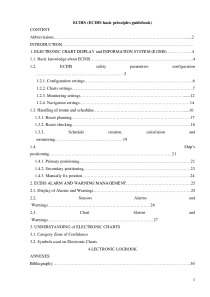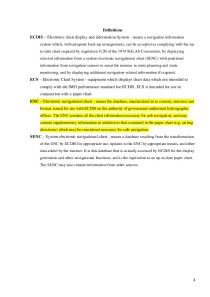ECDIS: ECDIS Basic Principles Guidebook



Abbreviations. Introduction. Electronic chart display and information system (ecdis). Basic knowledge about ECDIS. ECDIS safety parameters configuration. Configuration settings. Charts settings. Monitoring settings. Navigation settings. Handling of routes and schedules. Route planning. Route checking. Schedule creation, calculation and monitoring. Ship’s positioning. Primary positioning. Secondary positioning. Manually fix position. Ecdis alarm and warning management. Display of Alarms and Warnings. Sensors Alarms and Warnings. Chart Alarms and Warnings.
This methodological material was prepared in consideration of requirements of the international requirements:
This methodological material explains the understanding and ability to interpret and react properly to all kinds of alarms and warnings of system data, charts, navigational sensors and indicators.
have possibility to operate from main and emergency source of electrical power.
The main benefit of ECDIS is ensure the ability to:
free the mariner for maintaining a proper and safe lookout and for collision avoidance;
enable the mariner to execute the continuously plotting the ship’s position.
All masters and deck officers of the ship which are fitted with ECDIS sould be familiarized with that system and have a thorough knowledge and understanding one safe and effective use of the system described in the
IMO resolution MSC.1/Circ.1503/Rev.1. ECDIS- Guidance for good practice, 2017 and take into account provisions laid down in the 1978 STCW Convention competence requirements A-II/1 and A-II/2.
The composition of ECDIS components is shown in the Fig. 1.1. 5.3 INTEGRATION OF OTHER NAVIGATION SYSTEMS
ECDIS should be adjusted for proper use, taking into account the following safety items:
The adjustment options can be found in the following Task List windows: Configuration, Charts, Monitoring and Navigation.
On Configuration panel can be set measurement units, general setting, radar settings, time zone and get information about license validity and working status of the external devices.
F-distance (Forward distance) is important value changing the course to the new route leg. It is a distane measured in metres- the straight line from the start of manueuvre to the start of the turn. F-distance assure that vessel will end up on the next course line with minimum deviation XTD. F-distance can be entered for three loading conditions: Loaded, Medium and In Ballast. It presents as Wheel Over Line (WOL) on the route. The value can be set or changed only at the moment when no one route is activated. On activation of the route for monitoring the value of F-dist is locked. In the Fig. 1.2 is shown how to find the F-distance value from manoeuvring booklet.
Fig. 1.2. F-distance value on the ship’s turning circle (TRANSAS LNG 14 full load manoeuvring characteristic)
All settings on the Chart panel which can be found in the Task list (General, Layers and ENC windows) is related with chart visualization on the display.
For continuous operation of ECDIS on the display should be presented the most suitable chart for this area. There are three selections of loading charts:
Chart autoload ON - allows the automatic uninterrupted display of the chart taking intoaccount the setting of autoscale and chart priority;
ENC charts have a feature to show or hide some information which can prevent us from overloading the chart with excessive data. We can reduce the displayed information overloading configuring the chart layers selecting the display type: Base, Standard, Custom or All. Thus we can switch off unnecessary visualization. The Base configuration should not be used for navigation. As a minimum the Standard display should be used as the display on ECDIS for Navigation purpose.
- Transport Individual works
- Microsoft Word 9218 KB
- 2022 m.
- English
- 36 pages (7870 words)
- College
- Dovydas

















